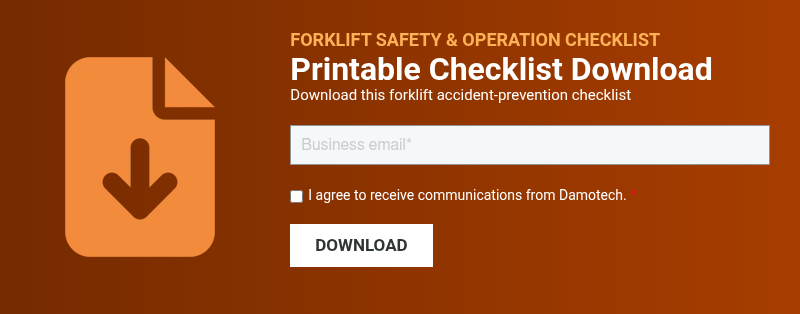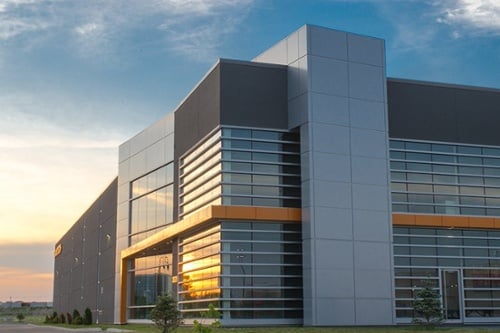Quick stats: In warehousing, forklifts remain one of OSHA’s most frequently cited hazards. Turnovers (tip-overs) account for a significant share of forklift fatalities. Prevention hinges on OSHA-compliant operator training (29 CFR 1910.178), pre-shift equipment checks, maintaining conservative travel speeds, ensuring clear pedestrian separation, and implementing proper rack impact protection.
Often called the “workhorses” of warehousing and construction, forklifts lift, carry, and unload heavy goods over short distances. For the efficient management of warehouse operations, you can count on them to deliver—when they’re used safely.
At the same time, operating a forklift involves risk. Forklifts can weigh several tons, multiple times the weight of a car. They’re rear-wheel steered, which alters turning dynamics, and most braking is applied to the front axle. As capable as they are, these vehicles can become dangerous when operated improperly or in unsafe environments.
Forklift Accident Snapshot (What matters for 2025)

Rather than chase competing year-to-year figures, focus on the risk patterns that don’t change:
- Tip-overs are a leading fatal event. Conservative speed, low-carried loads, and proper turning techniques are critical.
- People–truck interactions drive severe outcomes. Keep pedestrians on designated walkways and separate traffic flows.
- Environment and visibility matter. Clear aisles, good lighting, and impact protection reduce incidents and rack damage.
The Most Common Forklift Accidents (and How to Prevent Them)
Most incidents fall into the scenarios below. Use these controls to reduce the likelihood and severity of issues.
1) A forklift rolls or overturns
Why it happens: sharp/fast turns, elevated loads while traveling, and excessive speed.
Prevention
- Carry loads as low as practical and within the truck’s rated capacity.
- Turn slowly; avoid traveling with a raised load.
- Adopt conservative indoor speed limits and enforce them.
- Consider surface conditions (wet, oily, sloped) and reduce speed accordingly.
2) Workers are hit, struck, crushed, or pinned
Side crush during a tip-over is a major danger.

Prevention
- Use designated pedestrian walkways and physical/visual separation.
- Require operators to look in the direction of travel and maintain safe speeds.
- Post clear traffic signs and floor markings; eliminate blind spots where possible.
3) A worker falls while using a forklift to reach a height
Forklifts are not designed to elevate people unless using an approved work platform designed for that truck.
Prevention
- Use a MEWP (man lift/aerial work platform) or approved work platform—not bare forks.
- Ensure proper PPE and training for elevated work.
4) Forklifts repeatedly impact racking systems
Racking isn’t designed to absorb repeated impacts. Seemingly “minor” hits compound over time and can lead to serious structural degradation or collapse. To understand common impact patterns, see frequent ways forklifts damage racks and key lessons from rack collapse videos.
Prevention
- Improve visibility with rear-view mirrors, mast cameras, and proximity sensors.
- Protect vulnerable rack components with base guards, column guards, and end-of-aisle protection.
- If damage already exists, use engineered rack repair solutions to restore the original load capacity and configuration.
- Maintain adequate aisle width, good lighting, and clutter-free intersections.
Who is Responsible if a Forklift Accident Occurs?
Responsibility depends on causation. If an operator fails to follow safe practices, they may be at fault. Employers may be liable for inadequate training or unsafe conditions. The Occupational Safety and Health Act requires employers to provide a workplace free from recognized hazards. Consult with legal counsel for jurisdiction-specific guidance.
OSHA Requirements: Training, Daily Exams & Safe Travel

Ensure all operators are trained, evaluated, and certified on the truck type and workplace conditions. Provide refresher training when conditions, truck types, or behavior warrant it. Before each shift, perform a pre-use inspection and remove any unsafe trucks from service.
Forklift Inspection Checklist (examples)
- Forks and mast: no cracks, bends, or leaks.
- Battery/LP systems: restraints intact; no leaks; caps/vents working.
- Horn, seat belt, lights, and brakes are all functional.
- Tires in good condition; no chunking; adequate pressure where applicable.
- Nameplate and load capacity plate legible and attached.
- Warning labels present; Operator’s Manual on truck.
Tip: Use OSHA’s sample pre-shift checklist as a baseline, then tailor to your fleet and environment.

Forklifts & Pallet Rack Damage: What to Do After an Impact
Safe operation is also about the environment. Keep aisles clear, protect rack frames and building columns at fork level, minimize mixed traffic at workstations, and post clear pedestrian and wet-floor signage. Where damage is found, document, prioritize by severity, and act—repair or unload as required.
How a Rack Safety Partner Can Help
Partner with a provider that offers engineered inspections, load capacity calculations, rack safety training, repair solutions, protection products, and software to track issues. Look for engineering expertise and national coverage to support ongoing compliance and continuous improvement.












